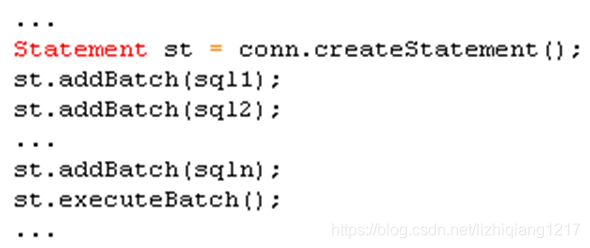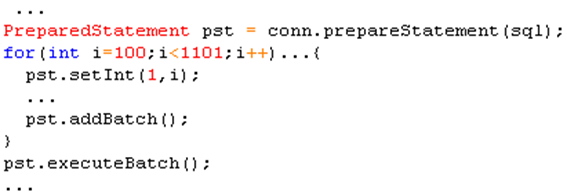Jdbc系列八:批量处理
2019-05-25 19:14
369 查看
当需要成批插入或者更新记录时。可以采用Java的批量更新机制,这一机制允许多条语句一次性提交给数据库批量处理。通常情况下比单独提交处理更有效率。
JDBC的批量处理语句包括下面两个方法:
addBatch(String):添加需要批量处理的SQL语句或是参数;
executeBatch():执行批量处理语句;
通常我们会遇到两种批量执行SQL语句的情况:
多条SQL语句的批量处理;

一个SQL语句的批量传参;


测试:
向 Oracle 的 customers 数据表中插入 10 万条记录。测试如何插入, 用时最短。
1、使用 Statement,用时 39567ms
@Test
public void testBatchWithStatement(){
Connection connection = null;
Statement statement = null;
String sql = null;
try {
connection = JDBCTools.getConnection();
JDBCTools.beginTx(connection);
statement = connection.createStatement();
long begin = System.currentTimeMillis();
for(int i = 0; i < 100000; i++){
sql = "INSERT INTO customers VALUES(" + (i + 1)
+ ", 'name_" + i + "', '29-6月 -13')";
statement.addBatch(sql);
}
long end = System.currentTimeMillis();
System.out.println("Time: " + (end - begin)); //39567
JDBCTools.commit(connection);
} catch (Exception e) {
e.printStackTrace();
JDBCTools.rollback(connection);
} finally{
JDBCTools.releaseDB(null, statement, connection);
}
}
2、使用 PreparedStatement。用时 9819ms
@Test
public void testBatchWithPreparedStatement(){
Connection connection = null;
PreparedStatement preparedStatement = null;
String sql = null;
try {
connection = JDBCTools.getConnection();
JDBCTools.beginTx(connection);
sql = "INSERT INTO customers VALUES(?,?,?)";
preparedStatement = connection.prepareStatement(sql);
Date date = new Date(new java.util.Date().getTime());
long begin = System.currentTimeMillis();
for(int i = 0; i < 100000; i++){
preparedStatement.setInt(1, i + 1);
preparedStatement.setString(2, "name_" + i);
preparedStatement.setDate(3, date);
preparedStatement.executeUpdate();
}
long end = System.currentTimeMillis();
System.out.println("Time: " + (end - begin)); //9819
JDBCTools.commit(connection);
} catch (Exception e) {
e.printStackTrace();
JDBCTools.rollback(connection);
} finally{
JDBCTools.releaseDB(null, preparedStatement, connection);
}
}
3、使用Batch批量操作,用时 569ms
@Test
public void testBatch(){
Connection connection = null;
PreparedStatement preparedStatement = null;
String sql = null;
try {
connection = JDBCTools.getConnection();
JDBCTools.beginTx(connection);
sql = "INSERT INTO customers VALUES(?,?,?)";
preparedStatement = connection.prepareStatement(sql);
Date date = new Date(new java.util.Date().getTime());
long begin = System.currentTimeMillis();
for(int i = 0; i < 100000; i++){
preparedStatement.setInt(1, i + 1);
preparedStatement.setString(2, "name_" + i);
preparedStatement.setDate(3, date);
//"积攒" SQL
preparedStatement.addBatch();
//当 "积攒" 到一定程度, 就统一的执行一次. 并且清空先前 "积攒" 的 SQL
if((i + 1) % 300 == 0){
preparedStatement.executeBatch();
preparedStatement.clearBatch();
}
}
//若总条数不是批量数值的整数倍, 则还需要再额外的执行一次.
if(100000 % 300 != 0){
preparedStatement.executeBatch();
preparedStatement.clearBatch();
}
long end = System.currentTimeMillis();
System.out.println("Time: " + (end - begin)); //569
JDBCTools.commit(connection);
} catch (Exception e) {
e.printStackTrace();
JDBCTools.rollback(connection);
} finally{
JDBCTools.releaseDB(null, preparedStatement, connection);
}
}
相关文章推荐
- JDBC addbatch批量处理数据时有最大值限制
- JDBC系列:(4)使用CablleStatement调用存储过程
- JDBC addbatch批量处理数据时有最大值限制
- Java Web系列:JDBC 基础
- JSP初级系列--Eclipse3.21+SQl 2005 JDBC数据库连接配置方法
- Java 数据库系列教程--线程池与普通jdbc的 比较
- 1 开发一个注重性能的JDBC应用程序不是一件容易的事. 当你的代码运行很慢的时候JDBC驱动程序并不会抛出异常告诉你。 本系列的性能提示将为改善JDBC应用程序的性能介绍一些基本的指导原则,这其中的原则已经被许多现有的JDBC应用程序编译运行并验证过。 这些指导原则包括: 正确的使用数据库MetaData方法 只获取需要的数据 选用最佳性能的功能 管理连
- JDBC系列教程(六)---可调用语句
- Java Jdbc减少与Oracle之间交互提升批量处理性能,到底该如何优化才好?
- Java系列之JDBC和ODBC之间的区别与联系
- JDBC批量处理
- JDBC批量处理与结果集
- Java基础系列15:JDBC中使用元数据分析数据库
- 老调重弹:JDBC系列之<驱动加载原理全面解析)
- Apache POI系列教程2-2:初学JDBC__第七节(DatabaseMetaData和ParameterMetaData)
- JDBC的批量处理数据
- 关于使用原生JDBC批量处理数据的问题
- 利用JDBC批量处理语句
- JDBC系列教程(二)---驱动设置
- 大数据系列之数据仓库Hive命令使用及JDBC连接
